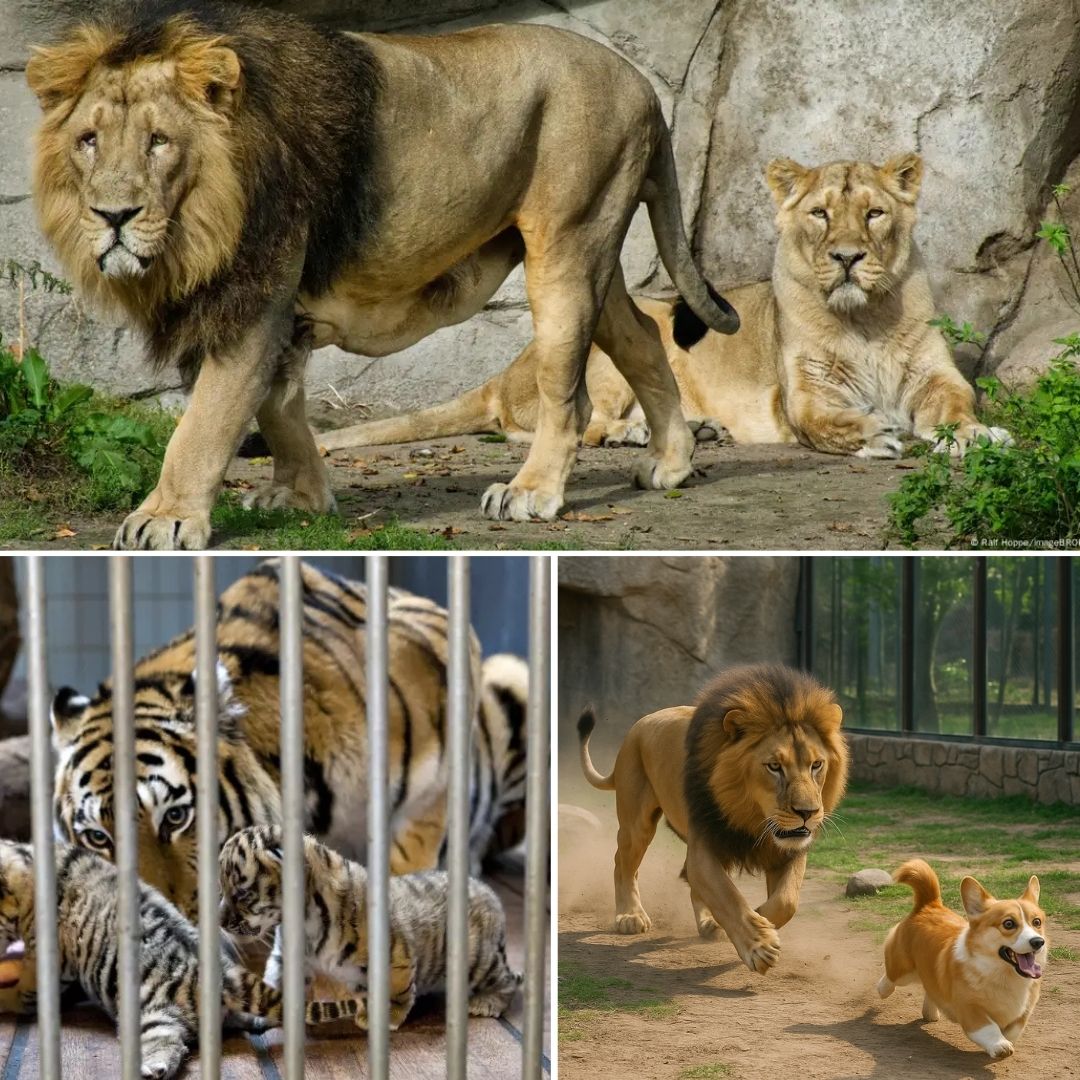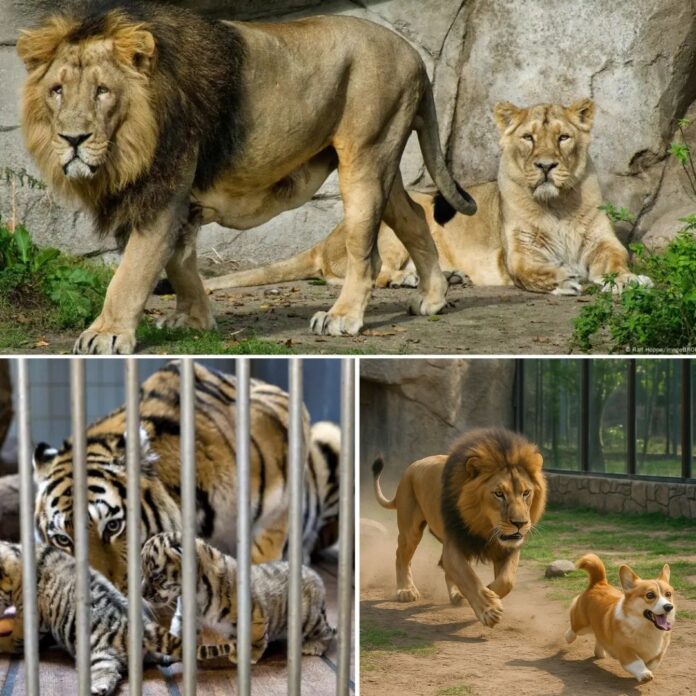ZOO’S SH0CKING PLEA SPARKS OUTRAGE!
A zoo is asking people to donate their “unwanted” pets to feed tigers, leopards, and lions. Is this a bold move for animal welfare or a heartless betrayal of trust? 😱

The Ethics of Feeding Pets to Predators: A Controversial Call from a Danish Zoo
Introduction
In early August 2025, Aalborg Zoo in Denmark ignited a firestorm of controversy with a public request that shocked animal lovers worldwide: they asked people to donate their “unwanted” pets—chickens, rabbits, guinea pigs, and even horses—to be euthanized and fed to the zoo’s predators, including lions, tigers, and European lynxes. The zoo defended the initiative as a way to mimic the natural food chain, ensuring the health and well-being of its carnivores. However, the announcement, accompanied by an image of a lynx baring its teeth, drew fierce criticism online, with some calling it “perverse” and others praising its commitment to natural diets. This article explores the details of the controversy, the cultural context of zoo practices in Denmark, the ethical dilemmas raised, and the broader implications for zoos globally.
The Announcement: A Call for Pet Donations
On July 31, 2025, Aalborg Zoo posted on Facebook, urging owners of “surplus” pets—specifically chickens, rabbits, guinea pigs, and horses—to donate them for use as food for its predators. The zoo emphasized that donated animals would be “gently euthanized” by trained staff to ensure a humane process before being fed to carnivores like the Asiatic lion, Sumatran tiger, and European lynx. The post, which included a link to the zoo’s website detailing donation protocols, stated, “In zoos, we have a responsibility to imitate the animals’ natural food chain – for the sake of both animal welfare and professional integrity.”<grok:render type=”render_inline_citation”>12</grok:render>
The zoo specified that small animals could be donated on weekdays between 10 a.m. and 1 p.m., with a limit of four at a time without an appointment. Horses, which must have a valid passport and no recent medical treatments, were also accepted, with donors eligible for a tax deduction based on the animal’s weight.<grok:render type=”render_inline_citation”>11</grok:render> According to Danish broadcaster TV2 Nord, the zoo had already received significant donations in 2025, including 137 rabbits, 53 chickens, 18 guinea pigs, 12 cod, and 22 horses.<grok:render type=”render_inline_citation”>13</grok:render>
Deputy Director Pia Nielsen defended the practice, noting that it has been a long-standing tradition at Aalborg Zoo. “For many years, we have fed our carnivores with smaller livestock. When keeping carnivores, it is necessary to provide them with meat, preferably with fur, bones, etc., to give them as natural a diet as possible,” she said.<grok:render type=”render_inline_citation”>8</grok:render> The zoo argued that whole prey, including fur and bones, provides essential nutrients absent in processed meat, a view supported by experts like Craig Packer from the University of Minnesota’s Lion Center.<grok:render type=”render_inline_citation”>8</grok:render>
Public Reaction: Outrage and Support
The announcement triggered a polarized response. On social media platforms like Facebook and X, critics expressed horror at the idea of turning pets into predator food. One commenter described it as “deeply perverse,” arguing that it disrespects the bond between owners and their animals.<grok:render type=”render_inline_citation”>12</grok:render> Another called for a boycott, labeling the request “absolutely unacceptable.”<grok:render type=”render_inline_citation”>12</grok:render> The term “pets” in the zoo’s messaging was particularly contentious, evoking images of cherished companions rather than livestock like chickens or rabbits. Due to “hateful rhetoric,” the zoo closed comments on its original post.<grok:render type=”render_inline_citation”>19</grok:render>
Conversely, some supported the zoo’s approach, praising its transparency and commitment to animal welfare. Supporters argued that donating animals that would otherwise be euthanized—due to old age, illness, or inability to be cared for—ensures they serve a purpose in sustaining other animals. In Denmark, where such practices are reportedly common, many see it as a pragmatic way to replicate natural diets.<grok:render type=”render_inline_citation”>10</grok:render>
Cultural Context: Denmark’s Unvarnished Approach to Zoos
Denmark’s zoos have a history of controversial practices that reflect a cultural willingness to confront the realities of animal management. In 2014, Copenhagen Zoo euthanized a healthy young giraffe named Marius to prevent inbreeding, dissecting its body publicly as an educational event and feeding its remains to lions.<grok:render type=”render_inline_citation”>9</grok:render> Weeks later, the same zoo euthanized four lions to make way for a new male, sparking further outrage.<grok:render type=”render_inline_citation”>14</grok:render> In 2015, Odense Zoo publicly dissected a lion in front of schoolchildren to control its population.<grok:render type=”render_inline_citation”>8</grok:render> These incidents highlight a trans-Atlantic divide, with Danish zoos prioritizing biological and educational goals over sentimental attachments, often clashing with global public sentiment.
Aalborg Zoo’s request aligns with this philosophy, emphasizing the nutritional needs of predators over emotional concerns about “pets.” The zoo’s website explicitly excludes dogs and cats from the program to mitigate backlash, focusing on animals like chickens and rabbits, which are often raised as livestock in Denmark.<grok:render type=”render_inline_citation”>8</grok:render> This cultural context helps explain why such a practice, while shocking to outsiders, is seen as routine by some in Denmark.
Ethical Dilemmas: Balancing Welfare and Sentiment
The controversy raises profound ethical questions. On one hand, zoos have a responsibility to provide nutritionally appropriate diets for their animals. The Nutritional Advisory Group to the Association of Zoos and Aquariums (AZA) notes that feeding whole carcasses to carnivores is a common management tool in the U.S., as it mimics natural diets and provides essential nutrients.<grok:render type=”render_inline_citation”>8</grok:render> However, the AZA does not endorse soliciting pets, highlighting a key difference in approach.<grok:render type=”render_inline_citation”>8</grok:render>
Critics argue that the emotional bond between owners and pets, even those like rabbits or guinea pigs, makes the request ethically problematic. The term “unwanted” pets can imply abandonment of animals that may still be loved, raising concerns about encouraging irresponsible pet ownership. Additionally, the public nature of the request—amplified by a provocative image of a predator—may desensitize people to the euthanasia process, even if it is humane.
On the other hand, the zoo’s initiative addresses practical realities. Animals surrendered to shelters due to housing issues or financial constraints often face euthanasia.<grok:render type=”render_inline_citation”>2</grok:render> By redirecting these animals to feed predators, the zoo argues it reduces waste and supports animal welfare. Yet, the lack of transparency about the volume of donations (e.g., 137 rabbits in 2025) raises questions about whether the zoo is encouraging over-donation or exploiting a loophole for cost savings.<grok:render type=”render_inline_citation”>13</grok:render>
Broader Implications for Zoos Globally
The Aalborg Zoo controversy prompts reflection on zoo practices worldwide. In the U.S., zoos typically source meat from commercial suppliers or use roadkill and livestock, avoiding public solicitation of pets due to ethical concerns.<grok:render type=”render_inline_citation”>8</grok:render> However, the nutritional argument for whole prey is universal, suggesting that zoos everywhere face a balancing act between animal welfare and public perception.
The incident also highlights the role of social media in shaping public discourse. The zoo’s Facebook post went viral, amplifying both support and criticism.<grok:render type=”render_inline_citation”>19</grok:render> Zoos must navigate this digital landscape carefully, as provocative messaging can backfire. Future initiatives might benefit from clearer communication—emphasizing livestock over “pets” and detailing the humane euthanasia process—to mitigate backlash.
Moving Forward: Lessons and Reforms
To address the controversy, Aalborg Zoo could adopt several measures. First, reframing the request to focus on livestock rather than “pets” could reduce emotional objections. Second, increasing transparency about euthanasia protocols and donation criteria could build trust. Finally, partnering with shelters to redirect animals already slated for euthanasia could align the program with broader animal welfare goals.
Globally, zoos can learn from this incident by establishing ethical guidelines for sourcing food. The AZA’s Nutritional Advisory Group could lead the way in developing standards that balance nutritional needs with public sentiment. Public education campaigns could also help demystify zoo feeding practices, fostering understanding of the biological needs of predators.
Conclusion
The Aalborg Zoo’s call for pet donations has sparked a global debate about the ethics of feeding predators in captivity. While the zoo’s intent to mimic natural diets is grounded in science, the emotional weight of the term “pets” and the public nature of the request have fueled controversy. Denmark’s unvarnished approach to zoo management, rooted in cultural norms, contrasts with global sensitivities, highlighting the need for nuanced communication. As zoos worldwide grapple with similar challenges, the incident underscores the importance of balancing animal welfare with ethical considerations and public perception. For more on this story, reputable news sources offer deeper insights into the debate and its implications.
